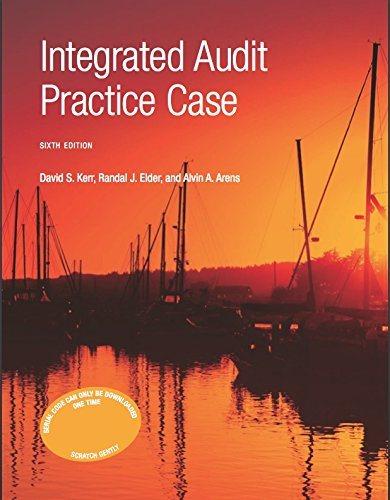Question
Substantive Audit Procedures: Cash Balances Lillian Stockton, the treasurer, prepares the monthly bank reconciliation. Don McKenna provided you with a copy of the reconciliation for
Substantive Audit Procedures: Cash Balances
Lillian Stockton, the treasurer, prepares the monthly bank reconciliation. Don McKenna provided you with a copy of the reconciliation for the month of December, 2009. You also obtained from Don selected portions of the cash receipts and cash disbursements journals. You have received directly from the bank the confirmation and cutoff bank statements that were requested January 4, 2010. The cutoff bank statements cover the period from January 1 to January 12, 2010.
The cutoff bank statement, along with items clearing during the cutoff period, which you requested from Big City National Bank, are shown in Exhibit 1. A selected portion of the cash receipts journal is provided as Exhibit 2, while a selected portion of the cash disbursements journal is shown in Exhibit 3. You may assume that checks written in December and not shown as clearing on the cutoff bank statement cleared on the December bank statement.
The following are the two working papers prepared for you by the client or obtained directly from the bank. The client prepared the bank reconciliation working paper, A-1. Having requested the bank confirmation from Big City National Bank, you received it (working paper A-2) directly from the bank.
Reference
Bank reconciliation-Big City National Bank A1
Standard bank confirmation-Big City National Bank A2
Required Exercises
1. Prepare a substantive audit program to test cash balances. The construction of such a program should begin with the five financial statement assertions: (1) existence or occurrence, (2) completeness, (3) rights and obligations, (4) valuation or allocation, and (5) presentation and disclosure. You should derive your specific audit objectives for cash balances from these assertions. Your audit program should address the five financial statement assertions, as well as any internal control weaknesses you have uncovered. In this regard, keep in mind the six control procedure categories, as well as the other internal control elements. You may assume that you have satisfied yourself as to any assertions not specifically mentioned in the narrative.
As you write your program, remember the generalized evidencegathering procedures of (1) recalculation, (2) physical observation, (3) confirmation, (4) verbal inquiry, (5) vouching of documents, (6) tracing, (7) scanning, and (8) analytical procedures. Use them to help you write the specific evidencegathering procedures in your program. Write your program on form AP1. Use the financial statement assertions as the major headings, or captions, for your program.
2. Study the prior year's working papers, paying attention to the use of tick marks to indicate your audit procedures, and the system of crossreferencing among working papers.
Gather evidence as necessary from the exhibits, the direct bank mailings, the clientprepared schedules, and your own observations to perform your audit work in the cash area by completing working papers A-1 and A-2.
Important Note: Mr. Lancaster, President of Peach Blossom Cologne Company, has asked you to record every adjusting journal entry that you find, regardless of materiality. You should add any such adjustments to the applicable working paper and also record them on working paper AJE (Schedule of Adjusting Journal Entries) and the working trial balance (working paper TBBS-TBIS). Recording these adjustments on working papers AJE and TBBS-TBIS as you find them will reduce your workload at the end of the audit.
Substantive Audit Program-Cash Balances
Assertions
Begin with the list of assertions below and add others as you think appropriate. Then write your audit program to test those assertions.
1. The amount of cash is not materially more than the amount shown on the balance sheet.
2. All cash has been recorded.
3. Cash is correctly shown as a current asset.
4. Cash is not restricted to noncurrent use.
Step by Step Solution
There are 3 Steps involved in it
Step: 1

Get Instant Access to Expert-Tailored Solutions
See step-by-step solutions with expert insights and AI powered tools for academic success
Step: 2

Step: 3

Ace Your Homework with AI
Get the answers you need in no time with our AI-driven, step-by-step assistance
Get Started


